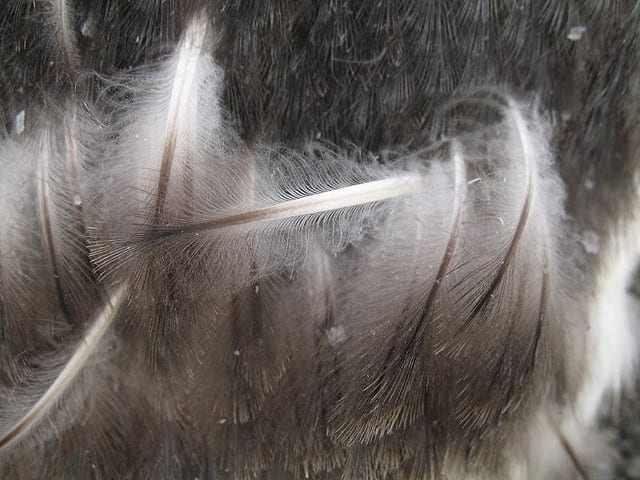Feathers of penguins trap air to retain warmth by being filamentous and forming a continuous layer around the body.
Penguin feathers offer a model for dynamic insulation, providing excellent insulation in both air and water and regaining loft automatically after compression. Penguins are unusual in that their feathers are not arranged in tracts, as in other birds, but instead are evenly packed over their surface. The feathers are short and stiff relative to other birds, comprised of an outer ’pennaceous’ or vane region and a ‘downy’ inner ‘after-feather’. The shaft of the feathers have a muscle attached to them that can pull them down into a compressed water tight barrier when under water, and then erect them again when they come back onto land. The upper parts of the vanes of the feathers overlap their neighboring feathers flatly like overlapping tiles, contributing to a wind or water barrier.
The deeper insulating layer is made up of after-feathers that are comprised of ever smaller components that create an ordered network of elements to create trapped air spaces. In Gentoo penguins, for example, there are about 47 barbs per feather and each of the barbs may have 1250 barbules emerging at a 60-80 degree angle from the central ramus (or stalk) in a spiral arrangement. Each barbule has its own tiny extensions, cilia, that are thought to provide a mechanism for attachment to neighboring barbules of other barbs, allowing them to only move in one direction relative to each other by a sort of ‘slip-stick’ mechanism. The overall effect of this structure is to create a uniform arrangement of barbules and thus a uniform division of and thickness of the trapped air space within the insulative layer. This slip-stick mechanism is thought to interact with the stored elastic energy in the barbs during compression under water to re-establish the correct spacing between barbs and barbules when back on land, for optimal still air space and thus insulative value. Bioengineers are studying not only the structural arrangements of the feather elements of penguins but also their mechanical properties in order to develop more effective insulative materials that could capture this clever self-organizing characteristic and ability to regain ‘loft’ after being compressed.












